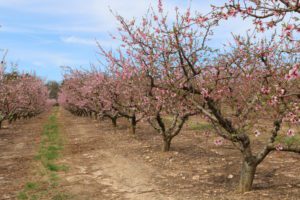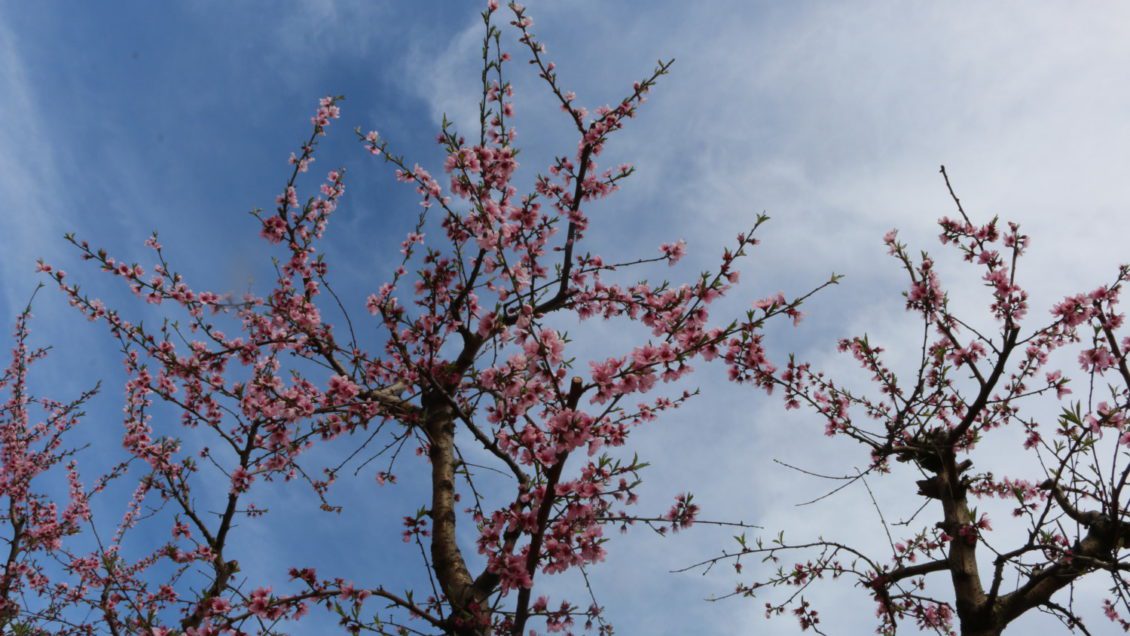CLEMSON, S.C. – Peach is one of the leading crops grown in the Carolinas and Georgia, and the Clemson University Cooperative Extension Service provides valuable information to help growers maintain their pole position.

This information includes how to detect and fight diseases, insects and weeds. Clemson Extension Peach Team members recently shared their knowledge about these vandals with growers during a Zoom meeting. One disease growers should be ready to defend their orchards against is brown rot. This disease drives peach tree spray programs in South Carolina and Georgia. Clean orchard floors are key in controlling brown rot.
“The disease cycle for brown rot begins early in the season,” said Guido Schnabel, a Clemson plant pathologist. “The brown rot fungus infects flower blossoms and in severe cases causes twig dieback.”
To minimize damage, Schnabel said growers should remove all fruit mummies and cankerous parts from trees.
“Orchard floor management also helps minimize spring spore release,” he said. “Strategically, the most important sprays are during bloom and the weeks leading up to harvest.”
In organic peach production, Schnabel advises growers to focus on soil and tree health, preserve beneficial insects and other microbes, and tighten spray intervals given that most organic products are only marginally effective.
“Brown rot is arguably the greatest challenge to manage for organic growers and research is in the works to find control options,” he said.
Several tools to help fruit growers have been developed by researchers in the Clemson Fruit Pathology Program. The MyIPM Smartphone App Series provides growers along the East Coast with information about fruit crop diseases, pests and disorders. App content is maintained in collaboration with fruit extension specialists at Clemson, Cornell University, University of Massachusetts, Pennsylvania State University, University of Maryland, North Carolina State University, the University of Florida and the University of Georgia.
MyIPM is a free app available in the Apple Store and Google Play.
Clemson post-doctoral scientist Madeline Dowling has created a video, MyIPM: App for Pest and Disease Management on Fruit Crops, to assist growers in learning how to use the app. This video is available online at https://vimeo.com/486538727.
Peach insects
In addition to diseases, insects, including the oriental fruit moth, San Jose scale and the plum curculio also can cause problems for peach growers. Brett Blaauw, a peach entomologist with a joint appointment between Clemson and the University of Georgia Cooperative Extension Services, said problems with the oriental fruit moth in South Carolina are more of an issue in the upstate.
“Adult moths emerge and mate shortly before bloom,” Blaauw said. “The most severe damage occurs later in the season when the larvae attack developing fruit.’
Oriental fruit moth management includes monitoring with pheromone traps. Blaauw advises growers to set one trap per 10 acres. Treat if 10 moths are found in one trap.
“Timing is crucial,” Blaauw said. “Deciding if and when to spray for the oriental fruit moth can be based on pheromone catches and using the degree-day model.”
The degree-day model predicts adult emergence and egg hatch for each of the five to six generations of oriental fruit moths during a season. To use the model, begin accumulating daily degree days when male flight begins in the spring (biofix). The biofix date is when pheromone traps detect the first sustained catch of two or more moths. Traps should be placed in orchards near the bud swell stage and checked one to two times per week. The traps should be hung at eye-level at a density of 1 trap per 10 acres of orchard. Check traps weekly after the biofix date.
Andy Rollins, a Clemson Extension county agent, has been monitoring the oriental fruit moth in the upstate. His traps estimate biofix beginning around March 18-25 of this year (2021). Degree Day Calculators are available from UGA Weather and Degreedays.net.
“Last year, this information was very important to upstate growers because it helped time the applications of pheromones which reduced insecticide use and provided better control of this pest than traditional methods,” Rollins said.
More information is available in the 2021 Southeastern Peach, Nectarine and Plum Pest Management and Culture Guide.
San Jose scale is another insect peach growers should pay attention to. Problems from this insect include branch dieback and eventually tree death if left untreated. Pruning peach trees to improve spray coverage and applying horticultural oil twice during the dormant season can help.
Additionally, combining an insect grower regulator, such as Centaur or Esteem with the oil can enhance the control of the scale. Combining Venerate with the delayed-dormant oil application has also shown to significantly suppress scale numbers compared to oil alone.
Blaauw provides updated information for insect control in his UGA Peach Blog. Information in the blog is applicable to South Carolina peach crops, as well as Georgia peach crops.
Plum curculio is a snout beetle native to North America. Early spring in the southeastern United States, the female plum curculio begins depositing eggs singly in a hole that she creates in the fruit at shuck split in peaches. Eggs in about five days and larvae feed in the fruit for 8 to 22 days. Full-grown larvae tunnel out of the peach, enter the soil and transform into pupae. First-generation adults usually emerge about four weeks after larvae enter the soil. The complete life cycle, from egg to emerged adult, requires five to eight weeks, depending upon the climate. There are usually two generations of plum curculio in Georgia and South Carolina.
Peach weeds
In addition to diseases and insects, peach growers also need to control weeds in their orchards. Wayne Mitchem, Extension associate and Southern Region Small Fruit Consortium coordinator from North Carolina State University, talked about successful weed management.
“Weeds will reduce yields in mature orchards,” Mitchem said. “In order to maximize yields and fruit size, growers must maintain weeds from bud break.”
Growers who use herbicides for weed control will be faced with some decisions to make in 2021. Surflan and oryzalin will not be available. Prowl will be the alternative. Brake On! is a new herbicide available this year, and Gramoxone has a new formulation.
Brake On! is labeled for use in some stone fruits, including peaches, but should not be used in orchards for more than two consecutive years. The new Gramoxone SL 3.0 formulation is more concentrated and requires less herbicide applied per acre. However, it does contain paraquat, so certain restrictions must be followed if using this herbicide including:
- Applicators must be certified.
- All paraquat applicators must complete EPA-approved paraquat training.
- Using a new closed-system packaging for paraquat-containing herbicides.
The closed-system packaging is designed to prevent transfer or removal of the pesticide except directly into proper application equipment. This prevents spills, mixing or pouring the pesticide into other containers or other actions that could lead to paraquat exposure. The closed-system packaging design requires use of an adaptor mounted to the mix bowl or spray tank for dispensing.
“Retailers will have the adapters,” Mitchem said.
In addition, Syngenta has a video available to teach people more about the closed-system packaging used for Syngenta products containing paraquat. The video, Gramoxone SL 3.0 Closed-System Packaging, is available on YouTube.
Peach is a main crop in the Carolinas and Georgia. According to the United States Department of Agriculture National Agricultural Statistics Service, more than 80,000 tons of peaches were produced in the Carolinas in 2020, while Georgia reported producing 28,000 tons.
-END-
Get in touch and we will connect you with the author or another expert.
Or email us at news@clemson.edu

